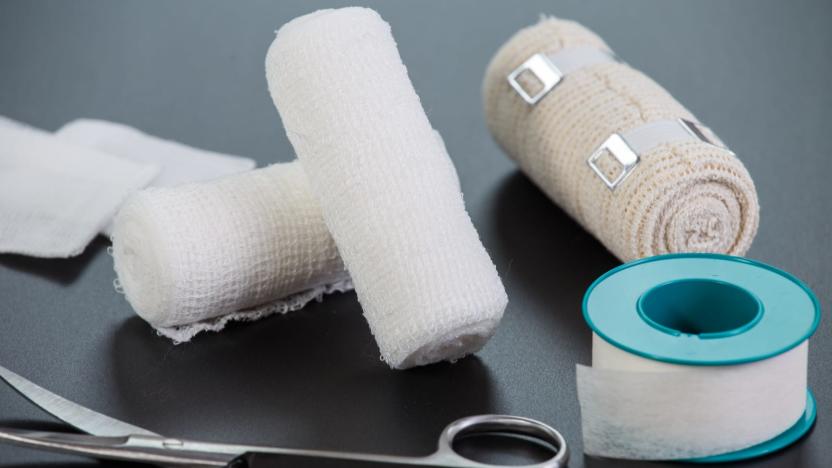drug delivery
Latest

Cell-based living robots can reproduce themselves
Scientists have developed living robots that reproduce themselves.

Color-changing bandages detect and treat drug-resistant infections
It may sound dramatic, but antibiotic resistance is one of the biggest threats to global health. According to the World Health Organization (WHO), it's urgent that we change the way we prescribe and use antibiotics. One approach might be to use bandages that sense and treat bacterial infections, even when the pathogen shows resistance. In a paper published by ACS Central Science, researchers from the Chinese Academy of Science explain how they've developed a way to do just that.

Scientists created living robots out of stem cells
Scientists have created a new life form that's something between a frog and a robot. Using stem cells scraped from frog embryos, researchers from the University of Vermont (UVM) and Tufts University assembled "xenobots." The millimeter-wide blobs act like living, self-healing robots. They can walk, swim and work cooperatively. Refined, they could be used inside the human body to reprogram tumors, deliver drugs or scrape plaque out of arteries.

Swimming nanobots target cancer cells inside your body
Scientists keep saying they'll put tiny robots into our bodies to cure disease, perhaps not realizing we may not be down with that. But the field is progressing rapidly, and researchers at the Israel Institute of Technology (Technion) have now found an artful way to propel such 'bots. They created a "nanoswimmer" the width of a silk fiber, made of several links of polymer and magnetic nanowires. After introducing it into a blood-like fluid, they applied an external oscillating magnetic field, propelling the nanobot the length of its body in a second.

MIT engineers use ultrasound for improved topical drug administration (video)
Ultrasound is likely most often associated with sonograms, but some MIT engineers are poised to change that. By using two separate beams of inaudible sound waves (one at low-frequency, the other high) the team were able to increase the permeability of skin, in a bid to improve the efficiency of transdermal drug delivery. The technique works thanks to the waves exciting bubbles in a fluid (such as water), forcing them to swell and move chaotically. Once the bubbles reach a certain size they implode, sucking the surrounding fluid into the void. This process creates micro-jets of liquid, which cause miniscule tears in the skin, allowing it to (painlessly) absorb chemicals more effectively. In practice, a pre-treated area of skin is then covered with a patch containing the correct dose of drugs -- but don't worry, the skin is said to grow back just a few hours later. Up until now, research into ultrasonic administration of drugs has concentrated on low-frequency waves, because the higher end of the spectrum doesn't have enough energy to pop the bubbles. Higher frequencies do, however, help create more of them and also limits their lateral movement. By using both high- and low-frequencies, the MIT engineers found this produced better over all results, by not only increasing the skin's uptake of the medicine, but also increasing the number of drugs that can be delivered this way. With pretty much anything that is usually delivered in capsule form being on the cards, this could make the administration of many popular drugs much more convenient and / or effective. Also excellent news for those who really don't like needles.

MIT duo successfully tests wireless drug-delivery microchips, more consistent than injections
Despise those daily injections of essential medication? Well folks, relief could be on the way. Over a decade ago, two MIT professors, Robert Langer and Michael Cima, first considered developing a drug-delivery microchip that could be wirelessly controlled. This past week, researchers in Cambridge -- alongside scientists from MicroCHIPS, Inc. -- announced that they have successfully used the aforementioned chip to give osteoporosis patients their daily allotment of teriparatide. "You can do remote control delivery, you can do pulsatile drug delivery, and you can deliver multiple drugs," Langer noted. Chips used in this particular study housed 20 doses each and results indicated that the delivery showed less variation than administered injections. In theory, microchips like these could be used alongside sensors that monitor glucose levels -- creating tech that could adapt to changes in a patient's condition. More info on the trial awaits in the source link below.[Thanks, Lydia]

NC State gurus find 'Goldilocks' of DNA self-assembly, look to improve drug-delivery vehicles
We're guessing that most Wolfpackers in the greater Raleigh area are in full-on tailgate mode right now, but aside from laying a beating on the Seminoles this evening, NC State faithful are also trumpeting a new DNA discovery that could one day make it easy to get vital drugs to hard-to-reach places within you. Researchers from the university have purportedly discovered the 'Goldilocks' of DNA self-assembly, which holds promise for technologies ranging from drug delivery to molecular sensors. The concept, known as DNA-assisted self-assembly, has been vastly improved by using "computer simulations of DNA strands to identify the optimal length of a DNA strand for self-assembly." You see, perfection occurs when strands aren't long enough to intertwine with each other, yet not short enough to simply fold over on each other. We know, it's a lot to wrap your brain around with half a hot dog shoved in your mouth, but hit the video after the break for a... shall we say, more visual explanation.

The PatchPump wearable drug-delivery system
The number of medical gadgets we've seen to ease medicine delivery is pretty staggering, with everything from the simple (digital pill box) to the insane (drug-infused false teeth). Now it looks like Israeli outfit SteadyMed is ready to enter the fray with the PatchPump, a wearable battery-powered drug pump that hits you with a constant dose of your prescription throughout the day. The system is based around a unique battery that gets bigger as it depletes, providing both the power supply and the motive force behind the pump. SteadyMed is working on version of the PatchPump that last from 48 hours up to 7 days, but there's no word on when these might hit hospitals.[Via MedGadget]





